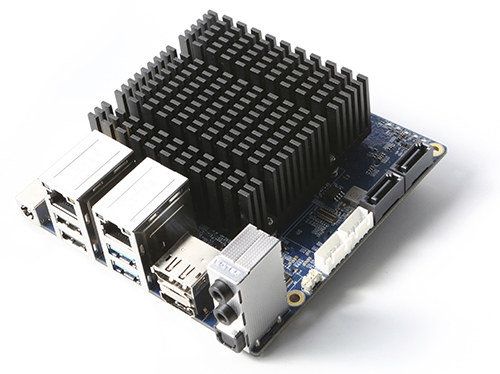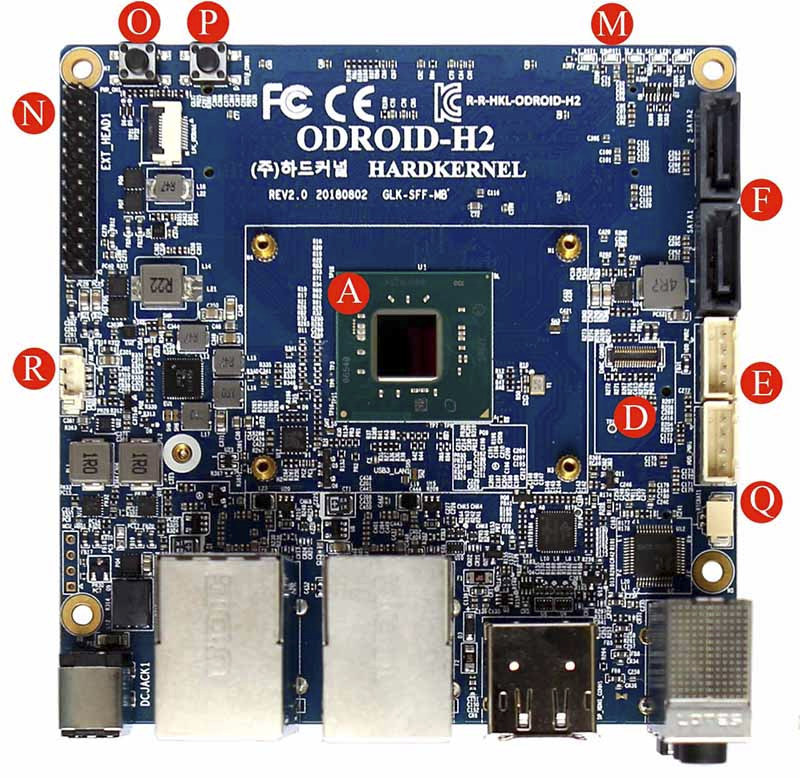Harkernel ODROID-H2 is an Intel Celeron J4105 Gemini Lake powered SBC that offers great value and performs reasonably well as we’ve seen in our ODROID-H2 Ubuntu review.
But there’s an upgraded model coming soon with ODROID-H2+ getting a slightly faster Intel Celeron J4115 processor, 2.5 GbE networking, a couple of extra I/O on the header for USB 2.0 and HDMI CEC, and a change to the 12V SATA power circuit to improve the suspend-resume power control sequence of 3.5″ HDDs.
ODROID-H2+ specifications:
- SoC – Intel Celeron J4115 Gemini Lake Refresh quad-core processor @ 1.8 GHz / 2.5 GHz (turbo single thread) / 2.3Ghz (turbo multi-thread) with 12EU Intel UHD Graphics 600 up to 700 MHz; Noted listed on Ark Intel just yet, but it’s real.
- System Memory – Dual-channel Memory DDR4-PC19200 (2400MT/s) supporting up to 32GB RAM in total
- Storage – M.2 PCIe 2.0 x4 slot for one NVMe storage, 2x SATA 3.0 ports, eMMC flash support
- Video Output
- HDMI 2.0 up to 4K (4096×2160) @ 60 Hz
- DisplayPort 1.2 up to 4K (4096×2160) @ 60 Hz
- Audio – HDMI, audio jacks for HP, MIC. and S/PDIF
- Connectivity – Dual 2.5 Gigabit Ethernet (RJ45) via RTL8125B chipset
- Expansion – 24-pin header with I2C, UART (3.3V), USB2.0 and HDMI CEC signals
- Misc – RTC battery (Included)
- Power Supply – 14V to 20V DC power input
- Dimensions – 110x110x43mm
- Weight – About 320 grams with heatsink, two DRAM modules, and M.2 NVMe SSD.
The board remains fully compatible with the original ODROID-H2 single board computer, and you can install Windows 10, Ubuntu 20.04, and other Linux operating systems on the board. Note, however, that you’ll need to either compile the Ethernet driver or install it as a DKMS package if you plan on using Linux. No extra drivers are needed for Windows 10. You’ll need an add-on board to use HDMI CEC.
The new board is really great for people wanting 2.5 GbE without breaking the bank, as ODROID-H2+ is up for pre-order for $119 on Hardkernel, and you can also find it on Ameridroid for $128.95 after applying coupon CNXSFWSUPPORTER6. Note you’ll also need to purchase a power adapter, one or two DDR4 SODIMM modules, as well as storage to make a complete system. Delivery is expected to start at the end of the month.

Jean-Luc started CNX Software in 2010 as a part-time endeavor, before quitting his job as a software engineering manager, and starting to write daily news, and reviews full time later in 2011.
Support CNX Software! Donate via cryptocurrencies, become a Patron on Patreon, or purchase goods on Amazon or Aliexpress






